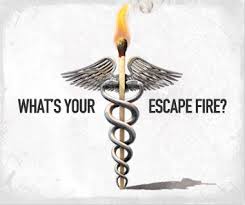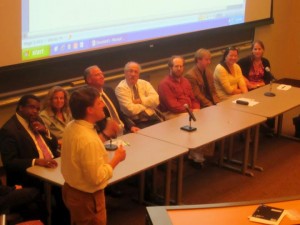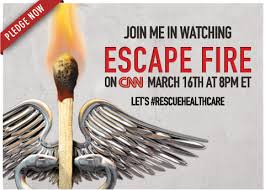Fledgling is thrilled to have provided early funding for the Escape Fire campaign and to have supported, with our funding partners, some of their targeted screenings. We congratulate the team on additional support from the Robert Wood Johnson Foundation that has allowed them to continue to reach and engage key stakeholders in transforming our healthcare system.
Even as they continue their work, we can share some key lessons from their campaign. Namely, the importance of using each screening opportunity to advance the campaign’s core goals and the power of strategic partnerships to help reach and engage professionals working within a system that needs to change.WHAT’S THE STORY?

WHAT WERE THE GOALS?
The vision for the film and audience engagement campaign is to transform healthcare and change how the public views health and healing. With this in mind, they laid out three goals: 1. Raise awareness: Give a straightforward understanding of the underlying causes of the American healthcare crisis 2. Mobilize viewers: Grow the movement to transform healthcare with partner organizations 3. Affect change: Inspire Americans to participate in this transformation on a personal and community level The Escape Fire campaign was designed to extend and grow the dialogue across multiple platforms and move the audience from passive moviegoers to active reformers.WHAT WAS DONE?

“We wanted the website to be a place where visitors could learn more about the issues but also offer their own solutions and begin to think about what they can do as individuals to change the system.” – Matthew Heineman, DirectorImportantly, the campaign also focused on offline engagement – organizing hundreds of community screenings. At this point, they have done over 750 non-theatrical community screenings. They provided support to screening organizers to help them create post-screening panel discussions and encourage issue-centered engagement. For example, like the online engagement, event attendees were asked to create “First Aid Kits” or describe their own “escape fire”, providing anyone who watched the film with an opportunity for action that required them to think about and develop possible solutions. These were then shared more broadly using social media. The campaign also leveraged their national broadcast, working with groups that could help them reach and engage their key stakeholders groups. For example, the campaign partnered with the National Student Nurses Alliance, the National League of Nurses, the American Association of Colleges of Nursing, Nurses Organization of Veteran’s Affairs, and the Visiting Nursing Services of New York to spread the word about the broadcast to the nursing community. These partners helped promote the event to their membership, co-wrote a nursing-focused insert for the screening discussion guide and aided in developing a national call-to-action. Using these specially designed tool kits and discussion prompts, nurses came together in small groups to facilitate conversations after the film and shared thoughts with others in their community and across the country. The campaign also targeted policy makers, military leaders and current and future healthcare providers. To reach healthcare students and future providers, the team facilitated two national screening events. In advance of the film’s theatrical release, Escape Fire organized a Fall 2012 “kick-off tour” that included simultaneous screenings at 60 medical schools for approximately 5,600 students, faculty, and community members around the country. In Spring 2013, the campaign partnered with the American Public Health Association and screened the film at 46 locations to roughly 2,500 students and professionals during National Public Health Week. To reach military providers, the Escape Fire campaign worked with the Veterans Health Administration Office of Patient Centered Care and Cultural Transformation to create a 30-minute version of the film that was live-streamed simultaneously for nearly 1,000 leaders at all 152 VA medical centers. Additionally, the film screened at the Pentagon for top military leaders, hosted by the U.S. Army Surgeon General. The campaign also worked to reach policy makers, encouraging members of Congress to see the film. In some cases, they sent copies to key members. Perhaps most intriguing, the campaign came up with a terrific way to reach and engage practicing physicians and nurses in the U.S. These groups are critical to creating change, but can be difficult to reach. In an unprecedented professional education opportunity, through a partnership with the American Academy of Family Physicians (AAFP), watching Escape Fire qualifies for continuing medical education (CME) credits. The AAFP is one of the largest national medical organizations, representing 110,600 family physicians, family medicine residents, and medical students nationwide. And, CME credits from the AAFP can translate via reciprocity into American Medical Association (AMA) Category 1 credits. By accrediting the film through AAFP, the campaign is able to offer CME credits to the largest possible number of physicians. To receive credit, physicians and other healthcare practitioners watch the film and then fill out a short survey hosted on the Escape Fire website. Building on this model, the campaign also partnered with Nurse.com to make Continuing Nursing Education (CNE) credits available to over 8 million nurses in the U.S. as well as continuing education credits for other groups such as dietitians, occupational therapists and health educators. In the first two weeks, more than 1,000 nurses participated in this opportunity – and the number continues to grow.
WHAT WAS ACHIEVED?

“Our partners have actively shaped our work throughout this campaign, and we’ve depended on them to give Escape Fire the largest possible impact each step of the way.” – Rebecca Stern, Outreach CoordinatorThe film has successfully reached and engaged practicing and future physicians and other health professionals who are critical players in changing our healthcare system. The Fall 2012 Kick Off Tour reached thousands of medical students, and the second tour reached even more medical schools with over 90 screenings nationwide in September 2013. Several viewers indicated that they will use the film in their ongoing course work. As one educator stated: “This movie has become part of my curriculum and I would recommend this documentary to everyone. It is a MUST SEE.” Others focused on how it inspired medical students. As the organizer at Florida International School of Medicine shared, “Many found that [Escape Fire] reminded them why they want to go into the medical profession and also that there is hope for the future with individuals of the mindset of those in the film.” In addition, hundreds of practicing physicians have claimed CME credit made available through AAFP. As of September 20th, 2013 650 physicians had claimed CME credits, and 97% of those stated that this activity supported improvement in healthcare.

